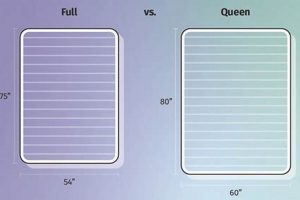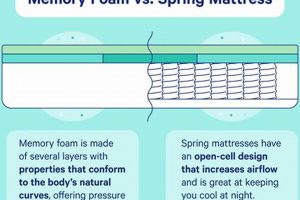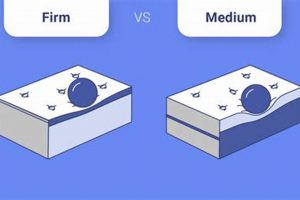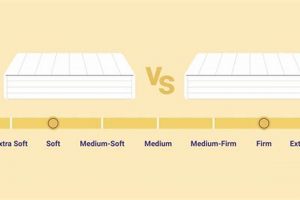Mattress thickness, often measured in inches, plays a significant role in comfort and support. A mattress described as “10 inch” indicates its vertical height from top to bottom, while “12 inch” denotes a greater thickness. This measurement influences factors such as the quantity of comfort layers, the depth of the support core, and the overall feel of the sleep surface. For instance, a thinner mattress might be suitable for lighter individuals or platform beds, whereas a thicker mattress may be preferred for enhanced cushioning and support by heavier individuals or those with certain orthopedic needs.
The height of a mattress directly impacts its performance characteristics. A greater profile often allows for more substantial comfort layers designed to contour to the body and alleviate pressure points. This can lead to improved spinal alignment and reduced tossing and turning during sleep. Furthermore, thicker mattresses may offer better motion isolation, preventing disturbances from a partner’s movements. Historically, mattress thickness has evolved with advancements in materials and manufacturing techniques, progressing from simple straw-filled ticks to complex multi-layered constructions.
The subsequent discussion will delve into the specific considerations when choosing between varying mattress heights. Factors to be addressed include sleeper weight, preferred sleeping position, bed frame compatibility, and individual comfort preferences. A thorough evaluation of these elements is crucial in determining the ideal mattress profile for optimal sleep quality.
Considerations for Mattress Height Selection
Choosing the appropriate mattress height requires careful consideration of individual needs and preferences. A misinformed decision can lead to discomfort and inadequate support, affecting sleep quality and overall well-being.
Tip 1: Assess Sleeper Weight: Individuals with higher body weights generally benefit from thicker mattresses that offer greater support and prevent bottoming out. A 12-inch mattress may provide adequate support, while a 10-inch mattress could compress excessively, leading to discomfort.
Tip 2: Evaluate Sleeping Position: Side sleepers often require thicker mattresses to cushion the shoulders and hips, promoting spinal alignment. Back and stomach sleepers may find adequate support in a 10-inch mattress, provided the support core is sufficiently firm.
Tip 3: Consider Bed Frame Compatibility: Ensure the chosen mattress height is compatible with the bed frame. Low-profile frames may benefit from a thicker mattress to achieve a comfortable sleeping height, while higher frames might necessitate a thinner mattress to avoid an excessively elevated sleep surface.
Tip 4: Account for Comfort Preferences: Individuals who prefer a plush sleeping surface may opt for a thicker mattress with more comfort layers. Those who prefer a firmer feel may find a thinner mattress with a denser support core more suitable.
Tip 5: Evaluate Edge Support Needs: Thicker mattresses often offer superior edge support, preventing sagging and making it easier to get in and out of bed. This is particularly important for individuals with mobility issues.
Tip 6: Consider Motion Isolation: A thicker mattress with advanced materials, such as memory foam or latex, can effectively isolate motion, minimizing disturbances from a partner’s movements. This is beneficial for light sleepers or those sharing a bed.
Tip 7: Review Material Composition: The materials used in the mattress construction influence its overall performance and durability. Research the properties of different materials, such as memory foam, latex, and innersprings, to make an informed decision.
Selecting the optimal mattress height requires a holistic approach that considers sleeper weight, sleeping position, bed frame compatibility, comfort preferences, and specific needs such as edge support and motion isolation. A well-informed decision contributes to improved sleep quality and overall well-being.
The subsequent sections will further explore specific mattress types and their suitability for various sleep preferences and requirements.
1. Support core depth
Support core depth, a key characteristic of a mattress, is directly related to its overall height. The choice between a 10-inch and 12-inch mattress necessitates a careful evaluation of the support core, as it dictates the mattress’s ability to provide proper spinal alignment and weight distribution.
- Material Composition and Density
The materials constituting the support core, such as high-density foam or innerspring coils, significantly influence its performance. A deeper support core, as found in a 12-inch mattress, may incorporate more durable and resilient materials, resulting in enhanced long-term support compared to a shallower core in a 10-inch mattress. For example, a 12-inch mattress might feature a high-density foam core engineered to withstand greater pressure and resist sagging over time, whereas a 10-inch model might utilize a less dense foam more prone to compression.
- Impact on Spinal Alignment
The primary function of the support core is to maintain proper spinal alignment during sleep. A deeper core, particularly in a 12-inch mattress, often provides greater conformity to the body’s natural curves. This can reduce pressure points and promote a more neutral spinal position. In contrast, a shallower core in a 10-inch mattress might lack the necessary depth to adequately support heavier areas of the body, potentially leading to misalignment and discomfort. Consider individuals with back pain, who often benefit from the enhanced support offered by a deeper support core.
- Influence on Weight Distribution
A deeper support core, typically present in a 12-inch mattress, facilitates more effective weight distribution across the sleep surface. This reduces localized pressure and prevents excessive sinking into the mattress. Effective weight distribution can contribute to improved circulation and reduced tossing and turning during sleep. Conversely, a 10-inch mattress with a shallower support core might concentrate weight in specific areas, resulting in discomfort and potential pressure sores over time.
- Effectiveness of Edge Support
The design and depth of the support core influences edge support. 12-inch mattress tends to have better edge support because of its thicker and sturdier support core. 10-inch mattress can have weak edge support and it can affect the user experience especially if they sit on the edge of the bed or sleep near the edge.
In summary, the support core depth is a critical determinant of mattress performance. A deeper support core, typically associated with a 12-inch mattress, generally offers enhanced durability, improved spinal alignment, and more effective weight distribution compared to a shallower core in a 10-inch mattress. Selection should align with individual needs and preferences, considering factors such as body weight, sleeping position, and potential orthopedic considerations.
2. Comfort layer quantity
Comfort layer quantity, directly affected by overall mattress height, significantly influences the sleep experience. A mattress described as “10 inch” or “12 inch” denotes its thickness, impacting the potential for comfort layer integration. Increasing the number of comfort layers enhances cushioning and pressure relief, contributing to improved sleep quality. For example, individuals experiencing joint pain often benefit from mattresses with multiple comfort layers designed to conform to the body and alleviate pressure points. A thicker mattress profile facilitates the accommodation of a greater number of such layers.
Conversely, a thinner mattress profile imposes limitations on the quantity of comfort layers that can be incorporated without compromising support. A 10-inch mattress may feature fewer comfort layers than a 12-inch counterpart, potentially resulting in a firmer feel and reduced pressure relief. This can be problematic for individuals with sensitivities to pressure or those who prefer a softer sleep surface. However, the specific materials used in the comfort layers, such as memory foam, latex, or polyfoam, also contribute significantly to overall comfort and performance, regardless of the mattress’s overall height. For instance, a 10-inch mattress with high-density memory foam comfort layers might outperform a 12-inch mattress with lower-density, less responsive materials.
In summation, comfort layer quantity is an important, but not sole, determinant of mattress comfort. While a thicker mattress profile allows for more extensive comfort layering, material quality and design are equally crucial factors. The ideal mattress thickness and comfort layer configuration should align with individual sleep preferences, physical needs, and budget constraints. A thorough evaluation of these variables will assist in selecting a mattress that provides optimal comfort and support for a restful night’s sleep.
3. Bed frame height
Bed frame height is a critical consideration when selecting a mattress, directly influencing the overall sleep surface elevation and accessibility. The choice between a 10-inch and 12-inch mattress must account for the bed frame’s height to ensure optimal comfort and ease of use.
- Standard Bed Height and Accessibility
A standard bed height, typically ranging from 20 to 25 inches from the floor to the top of the mattress, facilitates easy ingress and egress. Using a 12-inch mattress on a low-profile bed frame might result in an insufficient overall height, making it difficult for individuals with mobility issues to get in and out of bed. Conversely, placing a 10-inch mattress on a high platform bed frame may lead to an excessively elevated sleep surface, potentially creating a safety hazard. Careful consideration of these factors is essential to ensure safe and comfortable bed usage.
- Aesthetic Considerations and Room Proportion
The combined height of the bed frame and mattress significantly impacts the room’s overall aesthetic. A taller bed frame paired with a thicker mattress can create a more visually imposing presence, which may be desirable in larger rooms with high ceilings. Conversely, a lower bed frame and thinner mattress may be more appropriate for smaller spaces, preventing the bed from overwhelming the room. The choice of mattress height should complement the bed frame’s design and the room’s proportions to achieve a harmonious visual balance.
- Storage Space Underneath the Bed
Bed frame height directly correlates with the available storage space underneath the bed. A higher bed frame provides ample vertical clearance, allowing for the storage of bins, boxes, or other items. Conversely, a lower bed frame offers minimal or no storage space underneath. When selecting a mattress, individuals should consider their storage needs and choose a bed frame and mattress combination that provides adequate space for storage, if desired.
- Adjustable Bed Frames and Mattress Compatibility
Adjustable bed frames, designed to elevate the head and feet, require careful mattress selection to ensure proper functionality. A mattress that is too thick may exceed the adjustable frame’s range of motion or interfere with its mechanisms. A thinner mattress, such as a 10-inch model, may be more suitable for adjustable bed frames, allowing for greater flexibility and ease of adjustment. Always consult the adjustable bed frame manufacturer’s recommendations regarding compatible mattress thicknesses.
The interrelationship between bed frame height and mattress thickness directly influences accessibility, aesthetics, storage capacity, and compatibility with adjustable bed frames. A thorough assessment of these factors is crucial when deciding between a 10-inch and 12-inch mattress to achieve an optimal sleep environment that meets individual needs and preferences.
4. Sleeper weight capacity
Sleeper weight capacity represents a critical factor in mattress selection, significantly influenced by the mattress’s overall height, as denoted by dimensions such as “10 inch vs 12 inch mattress.” Understanding this relationship ensures optimal support, durability, and comfort, preventing premature wear and potential discomfort.
- Support Core Density and Compression
The density of the support core materials directly correlates with the mattress’s ability to withstand weight. A higher density core, often found in 12-inch mattresses, exhibits greater resistance to compression compared to a less dense core typical in 10-inch models. For example, a 12-inch mattress with a high-density foam or coil core may accommodate individuals weighing over 250 pounds more effectively, preventing sagging and maintaining spinal alignment. Conversely, a 10-inch mattress might exhibit premature compression and reduced support under similar weight conditions, potentially leading to discomfort and compromised sleep quality.
- Layer Composition and Weight Distribution
The number and composition of layers within a mattress contribute to its overall weight distribution capabilities. A 12-inch mattress, with its increased vertical space, can accommodate more substantial comfort and transition layers. This allows for a more gradual distribution of weight across the mattress surface, reducing pressure points and enhancing comfort, especially for heavier individuals. In contrast, a 10-inch mattress with fewer layers may concentrate weight in specific areas, leading to localized pressure and discomfort. The strategic arrangement of these layers impacts the mattress’s capacity to support varying weights effectively.
- Edge Support Reinforcement and Stability
Edge support reinforcement is crucial for preventing sagging and maintaining stability along the mattress perimeter. Thicker mattresses, such as 12-inch models, often incorporate more robust edge support systems, enabling them to accommodate heavier individuals who may sit or sleep near the edge of the bed. This enhanced support prevents the edges from collapsing under pressure, ensuring consistent comfort and preventing premature wear. A 10-inch mattress may feature less substantial edge support, potentially leading to sagging and reduced stability along the perimeter when subjected to higher weight loads.
- Long-Term Durability and Structural Integrity
The long-term durability and structural integrity of a mattress are directly influenced by its weight capacity. A mattress subjected to weight loads exceeding its design limitations will likely experience accelerated wear and tear, leading to premature sagging, reduced support, and compromised comfort. A 12-inch mattress, typically designed with higher weight capacities in mind, may exhibit greater resilience and maintain its structural integrity over a longer period compared to a 10-inch mattress subjected to the same weight loads. Proper mattress selection based on sleeper weight is essential to ensure long-term durability and optimal performance.
The interrelation of support core density, layer composition, edge support reinforcement, and long-term durability highlights the significance of sleeper weight capacity in selecting a mattress profile. While a 12-inch mattress generally offers enhanced weight capacity and support, individuals should carefully evaluate their specific needs and choose a mattress that aligns with their weight and sleep preferences. Understanding these factors allows for a more informed decision, ensuring a comfortable and supportive sleep surface that withstands the test of time.
5. Edge support stability
Edge support stability is a critical performance characteristic directly influenced by mattress height. The distinction between “10 inch vs 12 inch mattress” profiles reveals significant differences in this aspect. A mattress’s edge support refers to the structural integrity along its perimeter, impacting ease of entry and exit, usable sleep surface area, and overall durability. The increased vertical space in a 12-inch mattress often allows for enhanced edge support construction, typically through the incorporation of reinforced coils, high-density foam encasements, or other specialized designs. This added support minimizes edge compression, preventing the “roll-off” sensation and maximizing the usable sleep surface. In contrast, a 10-inch mattress may possess less robust edge support due to its limited vertical space, potentially leading to premature sagging and reduced comfort, particularly for individuals who sit or sleep near the edge of the bed.
The implications of varying edge support stability are significant in practical applications. For individuals with mobility challenges, a stable mattress edge facilitates easier and safer transitions in and out of bed. Furthermore, couples sharing a bed benefit from enhanced edge support, as it prevents either partner from inadvertently rolling off the mattress edge during sleep. In real-world scenarios, consider an elderly person relying on the edge of the bed for support while sitting down; a mattress with inadequate edge support could pose a safety risk. Alternatively, an overweight individual may find a 10-inch mattress with weak edge support providing inadequate and uncomfortable sleeping conditions. In both cases, a 12-inch mattress with enhanced edge support would offer a more suitable and secure sleep environment.
In summary, edge support stability is inextricably linked to mattress height, with 12-inch models generally offering superior support compared to 10-inch alternatives. This characteristic directly impacts comfort, accessibility, and safety, particularly for individuals with mobility issues or those sharing a bed. While specific edge support features vary across mattress brands and construction types, understanding the relationship between mattress height and edge support allows for more informed purchasing decisions, ultimately promoting a more restful and secure sleep experience. One challenge is that consumers often overlook edge support as they focus on other aspects like firmness. However, focusing on edge support and thickness ensures a more stable and safe bed for everyone to sleep on.
6. Motion isolation efficacy
Motion isolation efficacy, a critical determinant of sleep quality for co-sleepers, is directly influenced by the mattress profile. The dichotomy of “10 inch vs 12 inch mattress” highlights significant differences in this performance characteristic. A mattresss capacity to dampen and absorb movement, preventing its transmission across the sleep surface, dictates the degree to which one sleeper’s movements disturb the other. Greater mattress thickness, as found in 12-inch models, frequently correlates with enhanced motion isolation due to the increased capacity for incorporating specialized materials and layer configurations designed to minimize movement transfer. Materials like memory foam and latex, often present in comfort and transition layers, excel at absorbing and dissipating energy, thereby limiting motion propagation.
The practical implications of these distinctions are considerable. Consider a scenario where one partner frequently tosses and turns during sleep. A 10-inch mattress with limited motion isolation capabilities would likely transmit these movements, disrupting the other partner’s sleep and potentially leading to fatigue and reduced overall well-being. Conversely, a 12-inch mattress with enhanced motion isolation could significantly dampen these movements, allowing both partners to enjoy undisturbed sleep. Furthermore, the internal construction of the mattress plays a pivotal role. Pocketed coil systems, where individual coils are encased in fabric, reduce the transmission of movement compared to traditional interconnected coil systems. The combination of increased mattress thickness and specialized construction techniques can synergistically enhance motion isolation efficacy.
In summary, motion isolation efficacy is demonstrably linked to mattress thickness, with 12-inch models generally exhibiting superior performance compared to 10-inch counterparts. The integration of motion-isolating materials and specialized construction techniques within the mattress profile contributes significantly to its ability to dampen and absorb movement. Understanding these relationships allows consumers to make informed purchasing decisions, prioritizing motion isolation based on their individual needs and sleep preferences, particularly when sharing a bed. However, the efficacy also can be varied based on the material and the weight of the partners, but in general thicker mattresses have better motion isolation.
7. Overall mattress lifespan
Overall mattress lifespan is intrinsically linked to mattress thickness, a characteristic defined by the comparison of “10 inch vs 12 inch mattress” profiles. A thicker mattress, generally the 12-inch model, often exhibits a longer lifespan due to increased material volume and a more robust construction. This added material provides greater resistance to compression and wear over time. For example, a 12-inch mattress might retain its original support and comfort characteristics for 7-10 years, whereas a 10-inch mattress could degrade more quickly, requiring replacement within 5-7 years under similar usage conditions. The difference stems from the ability of the thicker mattress to distribute weight more effectively and withstand the cumulative effects of nightly use. A thicker mattress allows more room for higher quality components and longer lasting components in the support system and comfort layers.
The composition and density of materials used in each layer significantly influence mattress longevity. A 12-inch mattress with high-density foam and a robust coil system will generally outlast a 10-inch mattress utilizing lower-density materials. Practical applications include considerations for different sleeper types. For heavier individuals, a thicker mattress is more likely to maintain its structural integrity and support over time, preventing premature sagging and ensuring continued comfort. Conversely, a lighter individual may find that a 10-inch mattress provides adequate support for a reasonable duration, although it may still not match the longevity of a well-constructed 12-inch model. The overall construction and types of materials can contribute to longer life span.
In summary, mattress thickness, as defined by the “10 inch vs 12 inch mattress” comparison, plays a crucial role in determining overall lifespan. While material quality and sleeper weight contribute significantly, the increased volume and robust construction of thicker mattresses often result in greater durability and extended usable life. Challenges in assessing lifespan accurately arise from variations in manufacturing processes and individual usage patterns. Understanding this connection empowers consumers to make informed purchasing decisions, considering long-term value and potential replacement costs in addition to initial price.
Frequently Asked Questions
This section addresses common inquiries regarding mattress height, specifically the distinctions between 10-inch and 12-inch mattress profiles, providing factual information to aid in informed decision-making.
Question 1: How does mattress height impact overall support?
Mattress height directly influences the capacity for incorporating support layers and high-density core materials. A 12-inch mattress, owing to its increased vertical space, typically offers greater support and resistance to compression compared to a 10-inch mattress. This enhanced support is particularly beneficial for heavier individuals or those with specific orthopedic needs.
Question 2: What role does mattress height play in motion isolation?
Mattress height can affect motion isolation. While not the sole determining factor, a thicker mattress (12-inch) often provides enhanced motion isolation due to the ability to incorporate more substantial layers of motion-dampening materials, such as memory foam or latex. This can minimize disturbances for co-sleepers.
Question 3: Does mattress height influence edge support?
Generally, a taller mattress improves edge support. The 12-inch mattress often features improved edge support relative to the 10-inch model, which prevents the edges from sagging.
Question 4: How does mattress height affect bed frame compatibility?
Mattress height must be considered in conjunction with bed frame height to ensure comfortable ingress and egress. A 10-inch mattress on a high-profile frame may result in an excessively elevated sleep surface, while a 12-inch mattress on a low-profile frame may be more appropriate. The ideal combination achieves a comfortable overall bed height.
Question 5: Is a thicker (12-inch) mattress always superior to a thinner (10-inch) mattress?
Not necessarily. The optimal mattress height depends on individual needs and preferences. Factors such as body weight, sleeping position, and comfort preferences should be considered. A 10-inch mattress may be suitable for lighter individuals or those who prefer a firmer sleep surface, while a 12-inch mattress may be more appropriate for heavier individuals or those seeking enhanced cushioning.
Question 6: How does mattress height relate to longevity?
In general, a 12-inch mattress may exhibit greater longevity compared to a 10-inch mattress, assuming comparable material quality. The added material volume and robust construction of a thicker mattress provide increased resistance to compression and wear, potentially extending its usable lifespan.
In conclusion, mattress height is a significant but not isolated factor influencing mattress performance. Understanding the relationship between height and various performance characteristics, such as support, motion isolation, edge support, and durability, is essential for making informed purchasing decisions.
The subsequent section will explore various mattress types and their respective height profiles in greater detail.
Conclusion
The preceding discussion has explored the salient distinctions between “10 inch vs 12 inch mattress” profiles, emphasizing the interconnectedness of mattress height with key performance characteristics. Mattress thickness impacts support, motion isolation, edge support, bed frame compatibility, and long-term durability. A 12-inch mattress typically offers enhanced support and motion isolation and extended lifespan. Conversely, a 10-inch mattress may prove suitable for lighter individuals or those with specific bed frame considerations.
Ultimately, the selection of mattress height requires a synthesis of individual needs and informed evaluation. Consumers should carefully assess their body weight, sleeping position, comfort preferences, and bed frame dimensions to determine the optimal mattress profile. The information presented herein serves as a foundational resource for making judicious purchasing decisions, promoting improved sleep quality and overall well-being. It is recommended that individuals seek professional advice from sleep specialists or mattress retailers to refine their selection based on personalized assessments.




![Saatva vs Leesa Mattress: Which Bed Wins? [2024] Organic & Natural Mattress Buyer’s Guide: Non-Toxic Sleep Solutions Saatva vs Leesa Mattress: Which Bed Wins? [2024] | Organic & Natural Mattress Buyer’s Guide: Non-Toxic Sleep Solutions](https://mattressworldpa.com/wp-content/uploads/2025/07/th-1084-300x200.jpg)


